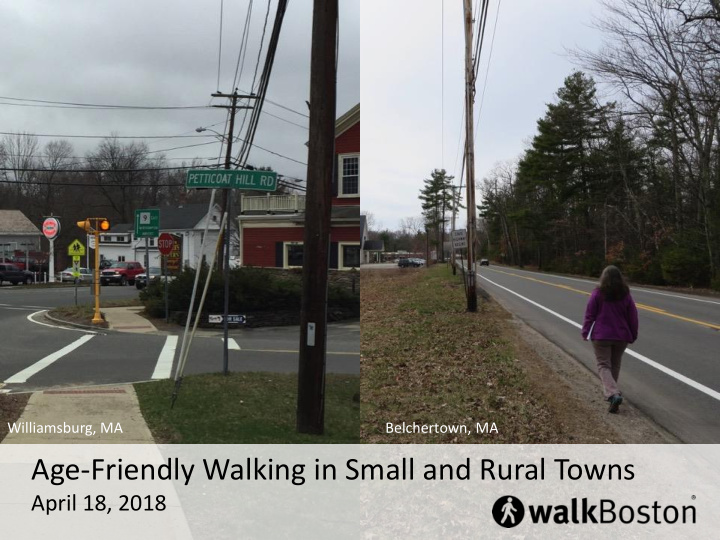



Williamsburg, MA Belchertown, MA Age-Friendly Walking in Small and Rural Towns April 18, 2018
What is Age-Friendly Walking?
What is Age-Friendly Walking? – Sidewalk conditions/maintenance – ADA compliance – Benches – Lighting – Shade – Public restrooms – Signals – Crosswalks – Traffic calming – … and more!
Age-Friendly Walking Principles • Walkability is key to ensuring that seniors can age in community, maintain good physical, cognitive and mental health, access important goods and services, remain socially and civically active, and maintain physical and economic mobility • Age-Friendly Walking presents a frame to bring new collaborators and diverse stakeholders together • Safe and comfortable walking for seniors means safe and comfortable walking for everyone!
Walkability in Practice • Connections • Destinations • Safety • Comfort
Walkability can be . . .
Allows people to get where they need to go • Streets and sidewalks balance walking, biking, transit and cars • Paths and crosswalks are where they are needed • Designing for all people – 8-80 philosophy
Variety • Mix of offices, shops, restaurants and residences • Lots of destinations that appeal to different people
Provide safe crossings and smooth walkways • Signs and crosswalks alert drivers to potential walkers • Walking surfaces are smooth and well-lit
Attract people • Banners and art contribute to civic pride • Festive lighting encourages evening activity year-round • Installations can activate street life
Walking and Walkability in Rural Communities • Character, scale and language • Rural walkway types • Common issues around walking in rural communities
MA towns are often six miles across
Perceptions of Rural Character Martha Levy, Winter Scene (1934)
Rural Walkways • Hiking trails • Regional multi-use trails • Road shoulders • Sidewalks with curbs • Roadside path • Meandering roadside path • Village Center
Hiking trails Metacomet-Monadnock Trail
Regional multi-use trails Minuteman Regional Trail
Road shoulder Taneytown Road – Gettysburg National Military Park
Sidewalk with curb Gardner, MA Belchertown, MA
Lincoln, MA
Lincoln, MA
Common issues around walking in rural towns and villages • Crossings • Connections to village centers • Narrow Right-of-Way (ROW) • Traffic speed Williamsburg, MA Williamsburg, MA
Focus areas in rural communities • Village Centers • Schools • Areas with higher densities • Areas of concern – high crash locations Boxborough, MA
Recent work in Rural Communities Belchertown ( pop’n 14,649) Lenox ( pop’n 5,025) Turners Falls ( pop’n 4,470) Northfield ( pop’n 3,032) Williamsburg ( pop’n 2,480) Huntington ( pop’n 2,180) Goshen ( pop’n 1,054)
Road design affects walkability
Traffic speed and pedestrian survival http://t4america.org
Road design elements to slow traffic • Narrow lane widths • Curb extensions • Raised crosswalks • Pavement markings
Lane widths • Lanes should be no wider than 10 feet on main streets • Narrowing a travel lane from 11 feet to 10 feet reduces speed by 7 mph • Striping can cut a 16-foot lane down to an 10-foot lane
Curb extensions • Shorten crossing distance • Make walkers more visible • Provide larger waiting areas (and space to store snow, away from walking zone) • Can provide informal public spaces
Crosswalks • T wo parallel lines is standard • Ladder is much more visible and widely recognized: worth the extra cost • Should be repainted regularly: visibility is key to effectiveness
Safer crossings • Raised crosswalks (aka speed tables) are visual, acoustical and physical reminders to slow down • In -street pedestrian signs warn drivers of mid-block crossings
Pedestrian elements to improve safety and comfort: • Wide, continuous, smooth sidewalks • Separation from curb (verge) • Few curb cuts; tight curb radii • Street furnishings (trees and benches) • Wayfinding signs
Passable sidewalks • Sidewalks should be continuous, unobstructed and clear • Hedges and trees should be trimmed
curb radius about 40 ft curb radius about 8 ft Tight curb radii (sharp corners) • Require drivers to slow down when turning into the driveway • Can be temporary installation or more permanent solution
Wayfinding • S igns with walking times reveal short distances between destinations • Encourage walking rather than driving
Turners Falls - Montague
Trees, benches, trash receptacles • Pedestrian scale elements that make people feel like they belong • Add vibrancy to main streets and town centers
Technical Assistance from WalkBoston • Pedestrian Advocacy 101 (“Ped 101”) community discussions • Local walking workshops (walk audits/assessments) • On-call strategic assistance and planning/design advice
Walk Assessment
Purpose of a walk assessment • Foster an awareness of the elements that contribute to the walking environment • Evaluate the safety and quality of the walking experience • Recommend improvements
Questions? anochur@walkboston.org walkboston.org/age-friendly walkboston.org/rural-walking
Recommend
More recommend